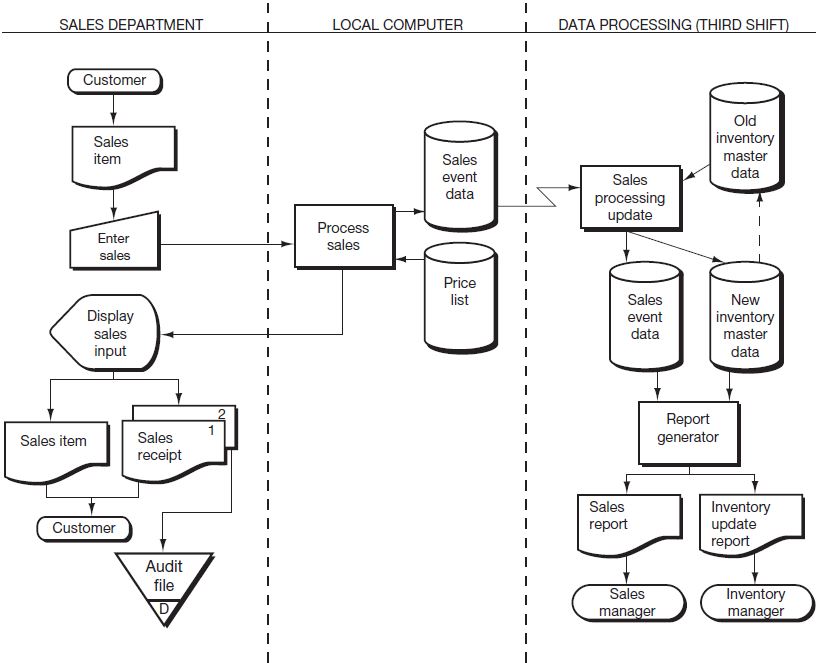Information technology improvements have provided a low-cost means for improving the efficiency of these traditional automated equivalents to manual systems. The most prevalent change has been the increasing use of online transaction entry to reduce redundancies in pure periodic mode processing (see Figure 4.2). In an online transactionentry (OLTE) system, use of data entry devices allows business event data to be entered directly into the Information System at the time and place that the business event occurs. These systems merge the traditional subprocesses of business event occurs (which includes completion of the source document) and record business event data into a single operation. At the point of the business event, a computer input device is used to enter the event data into the data entry system rather than onto a source document. Generally, the system automatically generates prices as the computer retrieves data from the system data stores. Such a system is considered online because the data entry device is connected to the processing computer. The input system usually also services a printer that then prints document copies to fill the still-needed role of source documents. As business events occur, the related data are usually accumulated on disk.

If we go back to our used books and CDs store scenario, it may be that you prefer to buy your books and CDs at one of the chain stores such as those found in shopping malls. When you take your books and CDs to the clerk at the counter in these types of stores, the clerk generally keys the purchase straight into the cash register. As noted in Figure 4.2, what is occurring at this point is that the sales items are being entered into a computer that is recording a log of the sales event, retrieving price list information, and generating duplicate copies of the sales receipt. One copy of the sales receipt is given to you (the customer), and the other is placed in the cash register drawer (for filing in the audit file). Note the differences between Figure 4.1 and Figure 4.2. The manual recording process (in Figure 4.1) by the sales clerk becomes a computer entry process (in Figure 4.2), and the record input process in Figure 4.1 becomes part of process sales in Figure 4.2. Other than these changes, the two flowcharts are the same.
The use of OLTE eliminates the need to have one person enter business event data on a source document and then have a second person perform the data entry to convert the business event data to a computer-ready form. In an OLTE system, one person performs both operations. In many systems, this data entry will be completed using bar code readers or scanners. The use of such technologies eliminates the human error that can result from entering data manually. Thus, in many OLTE systems the only human impact on the accuracy of the input data is the necessity to scan items properly into the system. Various control procedures that assure data accuracy are discussed in detail in Chapter 9.
It should be noted that the processing of the data in Figure 4.2 is still completed on a batch of event data at a later point in time. In the case of many systems in use by businesses today, sales event data is aggregated by cash register terminals for the entire day; and then, after the store has closed, the data is electronically transferred to the computer system where the business event data is processed. This process is reflected in Figure 4.2 by the communications line connecting the sales log in the sales department with the program procedures in data processing. The processing is completed overnight (note the reference to third shift in the column heading for data processing) while all stores in a region are closed, and updated reports are periodically generated to reflect the sales event updates to the master data.
Note here that the use of electronic communication technology does not change the traditional periodic approach, but rather makes the approach much more efficient. Thus, we encounter one of the first steps in the evolution toward e-business systems.
Periodic mode systems had long been the most common method for completing business event data processing, but in the last decade, they have become much less common for most activities. However, for some applications, periodic mode processing is almost always the preferred approach. For instance, payroll systems are a natural match with the batching of business event data, since all employees are generally paid on a periodic basis and all at the same time. It is almost unrealistic to think that such an application will eventually be processed using systems other than periodic mode.
|
Review Question Explain how the use of online transaction entry (OLTE) can increase efficiency when using batch processing. |
- 8994 reads






